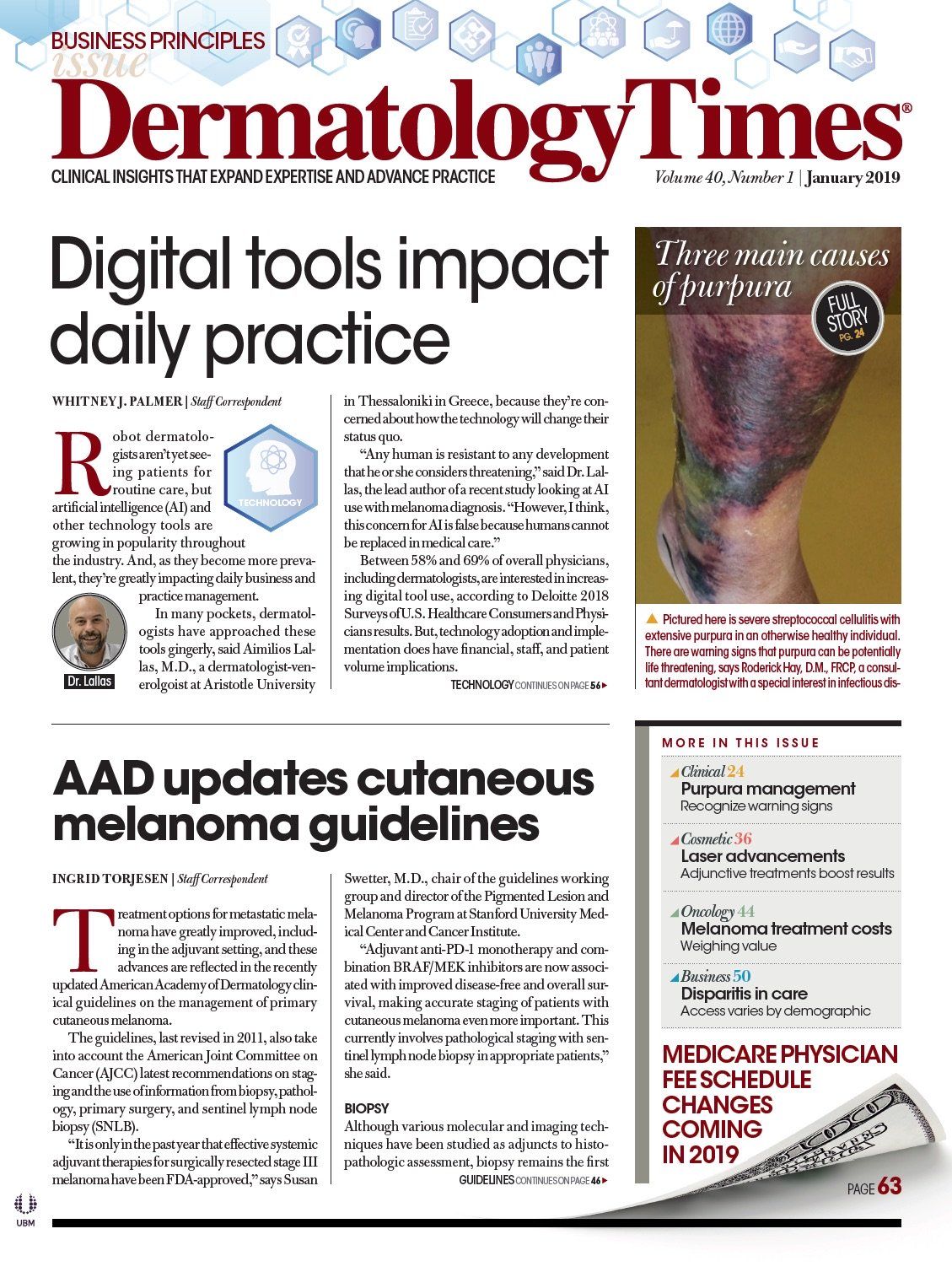
- Acne
- Actinic Keratosis
- Aesthetics
- Alopecia
- Atopic Dermatitis
- Buy-and-Bill
- COVID-19
- Case-Based Roundtable
- Chronic Hand Eczema
- Chronic Spontaneous Urticaria
- Drug Watch
- Eczema
- General Dermatology
- Hidradenitis Suppurativa
- Melasma
- NP and PA
- Pediatric Dermatology
- Pigmentary Disorders
- Practice Management
- Precision Medicine and Biologics
- Prurigo Nodularis
- Psoriasis
- Psoriatic Arthritis
- Rare Disease
- Rosacea
- Skin Cancer
- Vitiligo
- Wound Care
Publication
Article
Dermatology Times
Improving the reporting of social media recruitment for clinical trials
Author(s):
In this article, Katja Reuter, Ph.D. critiques a study by Katz and colleagues on the effectiveness of using digital platforms to recruit for an atopic dermatitis study.
The popularity of social media has created a new opportunity for the research community to recruit study participants.
Recent data indicate that nearly 70% of U.S. adults use some social media1. Coinciding with the surge of social media adoption, study teams increasingly report the use of social media to enhance recruitment in clinical research with promising but mixed results2,3. Recruitment of study participants is a significant problem, particularly in clinical trials. It remains a critical roadblock to successful clinical and translational research4,5.
In this issue of Dermatology Times, Katz and colleagues describe the results of a targeted advertising strategy on social media and search engines for 150 days. The goal was to recruit patients with moderate to severe atopic dermatitis in a randomized, double-blind, placebo-controlled, phase three trial and to evaluate the efficacy and safety of tralokinumab monotherapy.
While the authors cogently describe the need for new solutions to enhance clinical trial recruitment and the potential of social media, they overlooked the importance of methodology and data transparency. For example, to assess the recruitment success, it is essential to provide the exact measurements (rather than estimates “over 15,000 people being directed to the customized landing page through the advertisement”) and to include proportions such as enrollment rate1* or the message click rate2* to look at potential selection bias and generalizability issues. Equally important is to discern recruitment results by digital platform (they also mention search engine marketing via Google) and to include any data the authors used for comparisons.
Katz and colleagues conclude that the social media approach resulted in “significant improvement compared to similar previous trial engagements.” Another critical aspect is the transparency about the number of social media advertisements (ads) that were posted to promote the trial. Conclusions about the effectiveness of a social media recruitment strategy need to be examined in light of the invested ads budget.
Katz et al. provide valuable data demonstrating that social media can contribute to achieving the study accrual target, but any conclusions about the effectiveness drawn upon this study are inconclusive.
However, the lack of accurate, complete, and consistent reporting of social mediabased recruitment methods and results is not unique to this article. Due to the lack of standards, evidence supporting the efficacy of social media-enabled recruitment is limited, and questions remain with respect to optimal methodologies, benchmarks, metrics, and baseline data, and factors that influence the recruitment success, e.g., study target population, recruitment methods, type of disease or condition a study is recruiting for, characteristics of the recruitment messaging. For example, Katz and colleagues speculate that the pre-qualification via tele-dermatology impacted their recruitment results.
Social media-enabled recruitment should be reported transparently so that readers can follow what was planned, what was done, what was achieved, and what conclusions were drawn. Researchers need to develop and adhere to consistent and transparent methodology and reporting standards if we want to evaluate the effectiveness of social media-based study recruitment and patient engagement reliably and move toward evidence-based strategies. Â
References
1. Demographics of Social Media Users and Adoption in the United States. (2018) Available at: http://www.pewinternet.org/fact-sheet/social-media/.
2. Topolovec-Vranic, J. & Natarajan, K., 2016. The Use of Social Media in Recruitment for Medical Research Studies: A Scoping Review. - PubMed - NCBI. Journal of Medical Internet Research, 18(11), p.e286. Available at: http://www.jmir.org/2016/11/e286/.
3. Whitaker C, Stevelink S, Fear N. The Use of Facebook in Recruiting Participants for Health Research Purposes: A Systematic Review. J Med Internet Res 2017;19(8):e290. DOI: 10.2196/jmir.7071 PMID: 28851679 PMCID: 5594255.
4. Bower, P. et al., 2014. Interventions to improve recruitment and retention in clinical trials: a survey and workshop to assess current practice and future priorities. Trials, 15(1), p.9. Available at: http://trialsjournal.biomedcentral.com/articles/10.1186/1745-6215-15-399.
5. Treweek, S. et al., 2018. Strategies to improve recruitment to randomised trials. - PubMed - NCBI. Cochrane Database of Systematic Reviews, 78, p.564. Available at: http://doi.wiley. com/10.1002/14651858.MR000013.pub6.
1* The number of people who consented and enrolled divided by the number of people who contacted the study team, for example using a contact form on a study webpage.
2* Number of impressions divided by the number of people who clicked on the link in the message to visit the study page. An impression is a viewable display of a social media post or ad, whether the post is interacted with (e.g., clicked, shared) or not.















Newsletter
Like what you’re reading? Subscribe to Dermatology Times for weekly updates on therapies, innovations, and real-world practice tips.










Rare Autoimmune Disorder Linked With Increased Risk of Certain Skin Cancers
Electrotrichogenic Niostem Device Promotes Hair Growth in Men with Androgenetic Alopecia
OCT and D-OCT Imaging Reveal Distinct Vascular and Dermal Patterns in Skin Photoaging Phenotypes
Guselkumab Effective in Real-World Korean Psoriasis Study
2 Commerce Drive
Cranbury, NJ 08512
All rights reserved.





